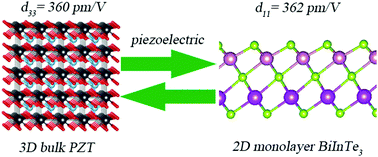New monolayer ternary In-containing sesquichalcogenides BiInSe3, SbInSe3, BiInTe3, and SbInTe3 with high stability and extraordinary piezoelectric properties†
Abstract
Looking for the high-performance alternatives to conventional lead-containing piezoelectric materials such as lead zirconate titanate (PZT) is absolutely vital for the development of low-dimensional innovative piezoelectric devices. Herein, we present our first-principles calculations on several new monolayers consisting of ternary In-containing sesquichalcogenides, which exhibit high stability and extraordinary piezoelectric properties. Our calculations predict that the in-plane (d11) and out-of-plane (d31) piezoelectric coefficients of BiInSe3, SbInSe3, BiInTe3, and SbInTe3 monolayers are much larger than those of most previously reported two-dimensional (2D) materials and widely studied wurtzite-type bulk piezoelectrics. Very strikingly, BiInTe3 monolayer possesses a d11 as high as 362 pm V−1 due to its mechanical flexibility, which is the highest among those reported in 2D materials and for the first time reaches those (∼360 pm V−1) in bulk lead-containing piezoelectric materials such as PZT. The theoretical predictions of the giant piezoelectricity in these 2D materials suggest that they have great potentials for the applications in atomically thin lead-free piezoelectric devices such as sensors and energy harvesters.



 Please wait while we load your content...
Please wait while we load your content...